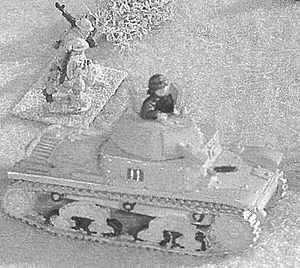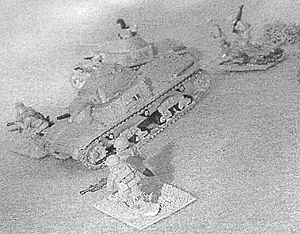 The military history enthusiast and the wargamer can readily find information on the armies of most of the major powers that participated in World War Two, but there is a paucity of information about the minor powers involved. In particular, the Italian army is a much neglected topic amongst wargamers and historians alike. I do not expect this article to create a surge of Italophiles, but I hope I can at least persuade a few brave souls to field an Italian wargame army.
The military history enthusiast and the wargamer can readily find information on the armies of most of the major powers that participated in World War Two, but there is a paucity of information about the minor powers involved. In particular, the Italian army is a much neglected topic amongst wargamers and historians alike. I do not expect this article to create a surge of Italophiles, but I hope I can at least persuade a few brave souls to field an Italian wargame army.
Italian M-13/40 Tank with accompanying infantry
Gene McCoy's Series 78 units (from the old Wargamer's Digest magazines). They are simply "bathtubbed" Orders of Battle) have provided me with a starting point for the creation of my Italian wargame army. My Italian unit is based on the Italian armored division of 1941. This allows me to recreate the battles fought in North Africa during World War Two. I prefer to outfit my unit with equipment that was available later in that year. In the future, I will provide alternative organizations for those who prefer the even greater challenge afforded by even more inferior equipment.
The core of the Italian armored division is its tank regiment. The regiment contained a headquarters element and three tank battalions. Each of the tank battalions contained a headquarters element and three tank companies. Each tank company contained three platoons of five tanks each. Therefore, our Series 78 Italian Tank battalion will be represented on the game table by ten tanks. These can be either M13/40 or M14/41 tanks. The battalion HQ will consist of one tank (either M13/40 or M14/41) and one recon AB-41 armored car.
The Italians also had an antiaircraft battalion and an antitank battalion in the armored division's artillery regiment, and our unit will have an attached AA/AT section. The AA/AT section will consist of one 90mm truck gun, a towed 20mm Breda AA gun and a towed 47mm AT gun. The 90mm truck gun is included to give the otherwise hopelessly outgunned Italians a chance against their opponents, but I found only a few mentions of this weapons system during my research.
Finally, the unit would not be complete without including supply and recovery elements. A unit of three supply trucks and a recovery vehicle will represent these. The wargamer could create this unit with Italian trucks, but to the best of my knowledge, no models exist for an Italian recovery vehicle. Therefore, the gamer may choose to use suitable German or British vehicles. A good choice would be the German recovery tractor based on the Sdkfz 11 chassis. The desert campaign is replete with examples of units using captured equipment. The Italian artillery units were the best units in their army, so the Italian player should be able to call on off-board artillery support. For this reason, the Italian Series 78 armored battalion should have an artillery forward observer unit represented by a Sahariana scout car with a forward observer stand.
The Bersaglieri motorized infantry units frequently supported the Italian tank units. A reinforced battalion of Bersaglieri infantry could support our Series 78 tank battalion. Two companies could represent this unit, each with three infantry stands and a medium machine gun stand. Each company could be carried in two medium trucks. A command stand, a staff car and a recon motorcycle stand would represent the Bersaglieri battalion's HQ A cannon company with two 65L17 infantry guns would directly support the Bersalieri Infantry Company; each towed by a light truck. Additionally, a portion of their parent regiment's weapon's battalion would support the Bersaglieri. I chose to represent this support element with a command motorcycle stand, a motorcycle combo with a machinegun, an 82mm mortar carried in a truck and a towed 20mm Breda AA gun.
Every World War Two wargamer has read numerous books and articles on German and Allied armored tactics, but there is not much out there about the tactics used by the Italian army. Adam Geibel published some basic information on Italian armored tactics in his Museum Ordnance article:
- "... The tank battalion trained to attack in company waves on fronts only 400m wide, or with two companies abreast on a 1,000m front with the rest in reserve. Standard formations included the column (used for tactical traveling), the 'V' (for uncertain situations that allowed the commander a compromise between massed firepower and control of the formation), line abreast (which put the most firepower on line), and echelon right or left (usually used by a unit on an extreme flank) ... In North Africa's swirling madness, the preferred formation was a modified line abreast, with each flank slightly refused to prevent unpleasant surprises."
Many accounts that I have read about Italian tankers show that they possessed great courage, but that they were poorly led and equipped. A fine example of this is contained in Ralph Zumbro's book, The Iron Cavalry. This passage is a description of an Italian tank attack against a hill position that came to be known as "The Pimple." The Italians had been cut off during their 1940 retreat across Libya at a place called Beda Fomm. The Italians tried desperately to get through the British forces barring their escape:
- "At 0800, 6 February, the first Italian tank attack came in a flashing wideopen charge against no more than two dozen hull-down cruisers, low on both fuel and ammunition. The M-13s came over open ground, firing as they came--that was their downfall. With no gun stabilization and with the crude optics of the time, they stood little, if any, chance of hitting the turrets of the British cruisers, which were all that was showing above the hilltops.
In the turrets of the cruisers the British sat and waited, all in full radio contact with their commanders. The Italians had radios in only commanders' tanks, so once the attack was launched, they had no control except flag signals. The Second RTR, under Colonel A. C. Harcourt, waited stationary until they couldn't miss their target. Then began a slow drumroll of controlled fire against targets coming straight at them, getting steadily larger in their sights. Wave after wave of M-13s broke against the cruisers. Between 6 and 10 Italian tanks were knocked out with each attack, and since they were used as soon as they came in, company by company, they never mounted a battalion-sized attack that would have easily overwhelmed the cruisers. As Erwin Rommel later asked a captured British officer, "What does it matter if you have more tanks then I, if you send them in driblets?"
The Italian army creates a difficult problem for the wargamer. The Italian tanks are poorly armored and slow. They possess an adequate 47mm gun, but it requires the Italian tanks to maneuver in close to get a kill. Additionally, heavily armored opponents like the British Matilda tank will require the Italian tanks to maneuver for a flank shot.
But how can you maneuver without speed?
The only answer is to use the bounding overwatch principle in your advance. One company of M-13/40's should remain stationary and act as a base of fire to pin your opponent while the other companies maneuver (bound) to the enemy's vulnerable flanks. The infantry and its support units should be close behind; available to clear towns and woods, which are not favorable terrain for the tanks.
 Italian tank infantry team.
Italian tank infantry team.
In the defense, the Italian tanks should try to obtain hull-down positions that give a measure of cover and concealment. If you can lure the enemy in close, your 47mm guns can be potent tank killers. Try to pick positions that will expose your opponent to fire on his vulnerable flanks or rear. The Italian infantry and guns should likewise find positions of cover and concealment and allow the enemy to come in close, unaware of the danger that awaits him. Be wary of probing attacks by the enemies reconnaissance units. If you must engage them, realize that you have now lost the element of surprise and that you now must disengage and maneuver to new defensive positions. Do this under the cover of a smoke screen and interdiction fire by your artillery.
You have an "ace in the hole" in your 90mm truck gun. This is a long range and devastating killer. On the offense, consider using it as a base of fire for your advance, but keep it out of range of your opponent's tanks and infantry guns. Once the enemy artillery has found the 90mm gun, it is time to reposition this useful, but vulnerable, tool. On the defense, lure your opponent across ground swept by the enfilading fire of the 90mm gun and the 47mm AT gun.
You can build your Italian units in several scales. 1/285th (you could also use 1/300th) scale vehicles and guns are available from GHQ miniatures. 1/300th figures can be purchased from Heroics & Ros. In 15mm, You can get most of the equipment and figures you need from Peter Pig and Quality Castings. I believe the Peter Pig line provides a large Lancia truck, which could be used to scratch-build the 90mm truck gun. Finally, in 1/76th scale you can get the M13/40 tank, a TL-37 light truck, and a Sahariana scout car from Crusader models (Available from Brookhurst Hobbies, see their ad in this issue). Mirliton makes 20mm figures which would be compatible with the 1/76th scale vehicles. Bandera models makes a 65mm mountain gun and a 75mm infantry gun in 1/76th scale. If you have a home computer, then you can find links to most of these manufacturers by accessing the webpage for "The Miniatures Page." This list is not exhaustive, and you may find additional niiniature lines to round out your units. Additionally, this list is not meant as an endorsement for any of the above-mentioned manufacturers.
The Italian army did not fare well in World War Two. It was inadequately armed and often poorly led in the field. The wargamer can rewrite history through the use of sound tactics. If you can win with this army, then truly you have become a skilled tactician. Are you equal to the challenge?
Back to Table of Contents The Messenger March 2002
Back to The Messenger List of Issues
Back to MagWeb Magazine List
© Copyright 2002 by HMGS/PSW.
This article appears in MagWeb (Magazine Web) on the Internet World Wide Web.
Other military history articles and gaming articles are available at http://www.magweb.com